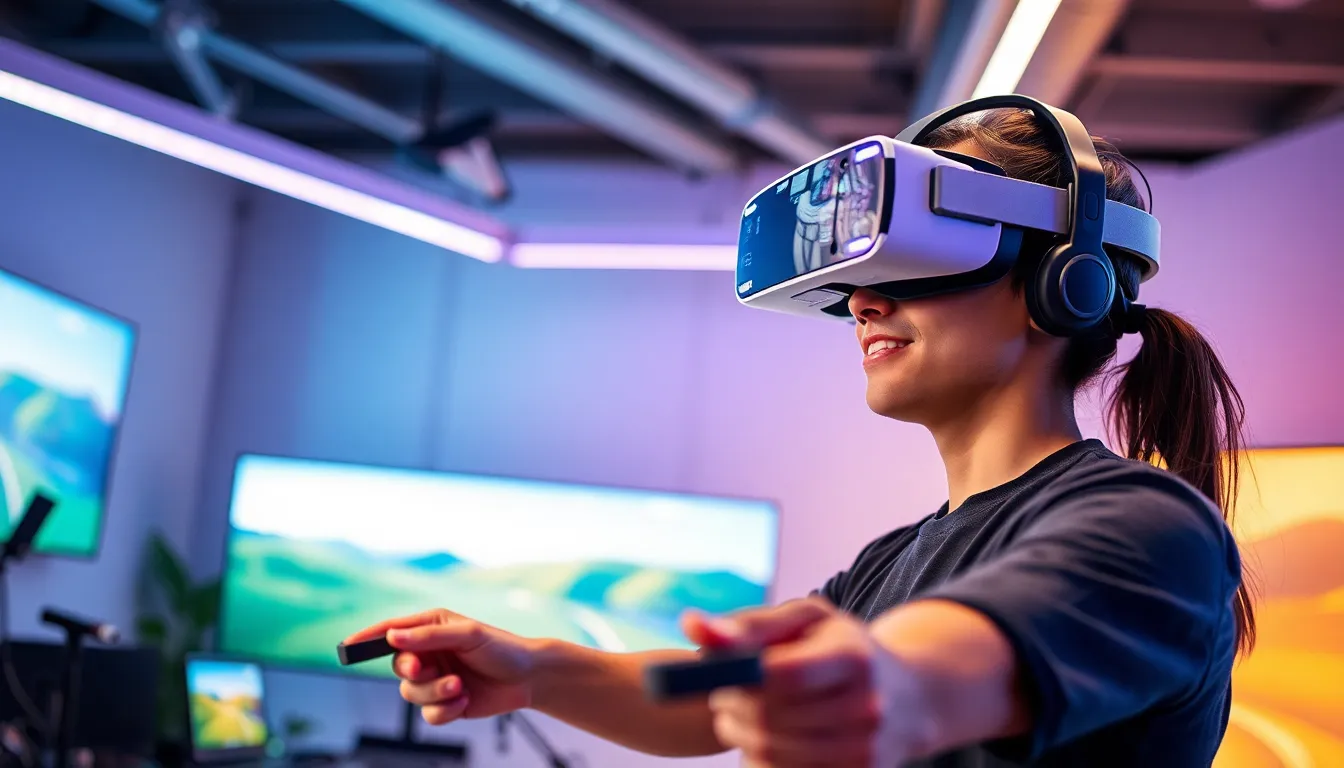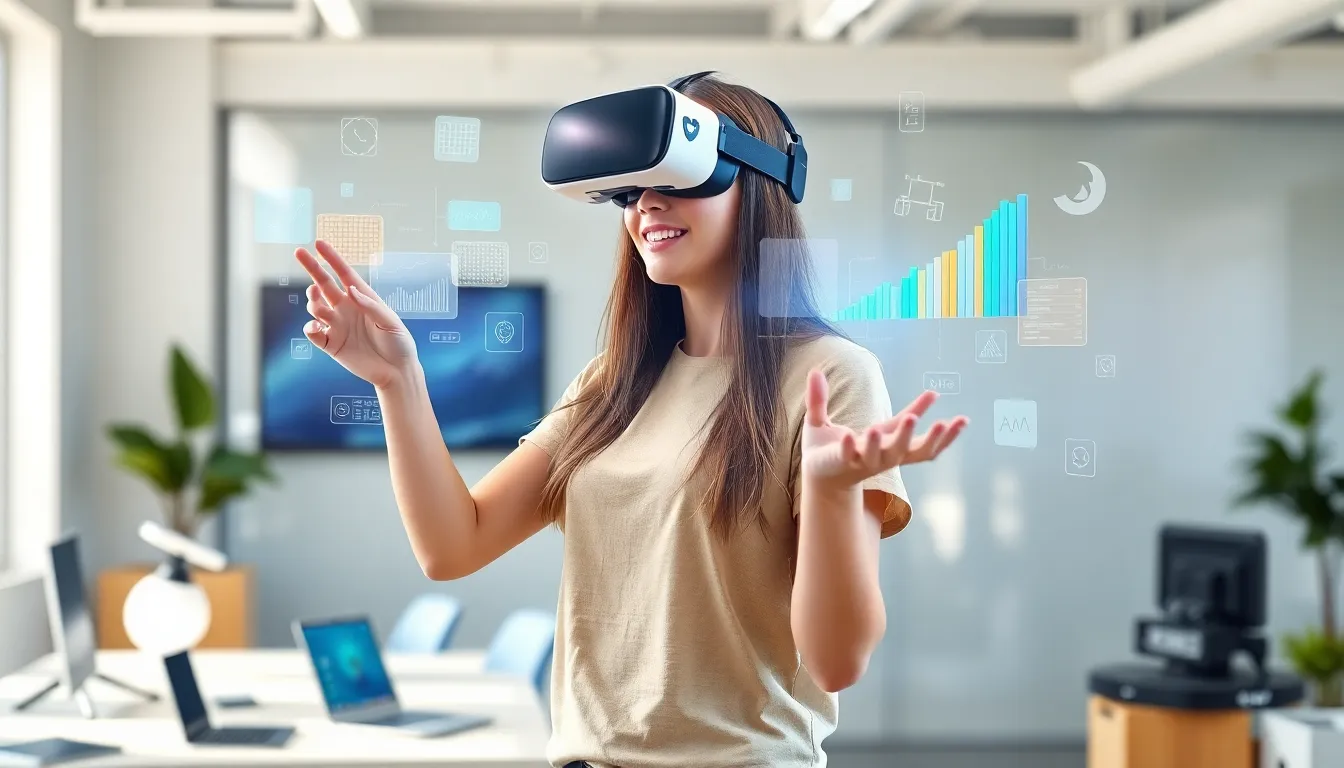The fusion of the Internet of Things (IoT) and virtual reality (VR) is transforming how people interact with technology. By connecting smart devices to immersive environments, users can experience a seamless blend of the physical and digital worlds. This combination not only enhances user engagement but also opens up new possibilities across various industries, from gaming to healthcare.
As IoT devices gather real-time data, VR can visualize this information in captivating ways. Imagine stepping into a virtual space where every object is connected and responsive to your actions. This innovative approach is reshaping how businesses operate and how consumers engage with products and services, making it essential to explore the potential of IoT and VR together.
Table of Contents
ToggleOverview of IoT and Virtual Reality
IoT and virtual reality represent two significant technological advancements, each transforming industries through enhanced connectivity and immersive experiences. IoT comprises interconnected devices that collect and exchange data, providing insights and automation across environments. Virtual reality transports users into computer-generated, immersive worlds, offering realistic simulations and interactivity.
Combining IoT with virtual reality creates a spectrum of applications that deepen user engagement. For instance, in gaming, IoT devices can track players’ movements and provide real-time feedback, enriching gameplay through responsive environments. In healthcare, VR can visualize IoT-generated patient data, improving diagnostics and treatment planning.
This integration fosters innovative business models. Retailers utilize VR to create interactive shopping experiences while drawing insights from IoT analytics, optimizing inventory management. Additionally, industrial sectors leverage these technologies to simulate training scenarios, enhancing safety and efficiency.
Organizations adopting IoT and VR gain a competitive edge. Industries leveraging these technologies can expect increased productivity, improved user satisfaction, and enhanced operational efficiency. By merging the capabilities of IoT devices with immersive virtual environments, the potential for new use cases continues to grow, transforming how businesses and consumers interact.
Key Technologies Behind IoT and Virtual Reality

IoT and VR rely on several key technologies that facilitate their integration and enhance user experiences. Understanding these foundation technologies is crucial for appreciating their potential.
Internet of Things (IoT) Explained
IoT refers to interconnected devices that communicate through the internet, collecting and exchanging data. Sensors, actuators, and connectivity protocols, like MQTT and HTTP, form the core components of IoT systems.
- Sensors: These devices capture real-time data, whether from environmental conditions or user interactions.
- Connectivity Protocols: IoT utilizes protocols like Zigbee, LoRaWAN, and Bluetooth to transmit data between devices securely.
- Data Analytics: Advanced analytics processes data from multiple sources, providing actionable insights that enhance decision-making.
- Cloud Computing: Cloud platforms store and manage vast amounts of data, allowing seamless access and processing.
IoT facilitates real-time interactions and brings physical elements into the digital realm, making it invaluable for industries such as healthcare, smart homes, and logistics.
Virtual Reality (VR) Fundamentals
VR immerses users in simulated environments, creating the illusion of being present in a computer-generated world. Several essential technologies contribute to effective VR experiences.
- Head-Mounted Displays (HMDs): HMDs like Oculus Rift and HTC Vive provide users with a 360-degree view, enhancing immersion through stereoscopic displays.
- Tracking Systems: Motion tracking systems, including inside-out and outside-in tracking, monitor user movements, allowing for natural navigation within virtual environments.
- Input Devices: Controllers and haptic feedback devices allow users to interact with the virtual world, enhancing engagement through tactile responses.
- Software Development Kits (SDKs): SDKs, such as Unity and Unreal Engine, enable developers to create immersive experiences by offering tools for graphics rendering and physics simulation.
VR enhances user interactions by creating safe environments for training, entertainment, and design, making it a vital technology in various sectors.
Applications of IoT and Virtual Reality
The integration of IoT and virtual reality leads to innovative applications across various sectors. Enhanced user experiences in gaming and revolutionized healthcare practices demonstrate the transformative potential of these technologies.
Enhancing Gaming Experiences
Gaming experiences benefit significantly from IoT and VR integration. Players interact with real-time data through wearables that track physical movements. This data informs game mechanics, allowing for more immersive environments. Developers leverage IoT to create adaptive gameplay that responds to players’ actions and environmental conditions, increasing engagement. Examples include smart game controllers that enhance player feedback and location-based VR gaming experiences that offer real-world interactions.
Revolutionizing Healthcare
Healthcare applications of IoT and VR transform patient care and medical training. Wearable devices collect health metrics, providing real-time data to healthcare professionals. VR simulations utilize this data to train medical staff in realistic scenarios without risk to patients. For instance, doctors practice surgical techniques in immersive environments, improving skills and confidence. Additionally, VR aids in patient rehabilitation by creating motivational environments tailored to individual capabilities, thereby improving recovery outcomes.
Challenges and Considerations
Integrating IoT and VR comes with several challenges that organizations must address. Security concerns and technical limitations play significant roles in the successful deployment of these technologies.
Security Concerns
Security risks present substantial challenges in the integration of IoT and VR. Vulnerabilities in IoT devices can compromise data integrity and user privacy. Hackers may exploit unsecured devices to gain access to sensitive information, which can lead to breaches in both personal and corporate networks.
To mitigate these risks, it’s essential for organizations to implement robust encryption methods and authentication protocols. Regularly updating software and firmware on devices can also prevent exploitation of known vulnerabilities. Ensuring compliance with data protection regulations further strengthens an organization’s security posture in IoT and VR environments.
Technical Limitations
Technical limitations can hinder the full potential of IoT and VR integration. High latency in data transmission may lead to lag in VR experiences, reducing user engagement. Bandwidth issues can also impair the seamless operation of numerous connected devices, affecting real-time data visualization.
Additionally, hardware compatibility poses challenges as various devices may not work well together. Investing in standardized components can improve interoperability between IoT devices and VR systems. Organizations should prioritize upgrading infrastructure to support higher bandwidth requirements. Careful planning and ongoing maintenance can alleviate many technical limitations, ensuring a smoother user experience.
Future Trends in IoT and Virtual Reality
Emerging trends in IoT and virtual reality (VR) point toward a more interconnected and immersive future. Advancements in artificial intelligence (AI) enhance data analysis capabilities, allowing IoT devices to become increasingly intelligent and responsive. AI facilitates personalized experiences in VR, enabling users to interact with customized environments that adapt to individual preferences and behaviors.
The proliferation of 5G networks significantly impacts IoT and VR integration. 5G offers lower latency and higher bandwidth, essential for real-time data transmission between devices. Enhanced connectivity fosters richer VR experiences, enabling seamless interactions and more sophisticated applications in areas such as smart cities, remote work, and telemedicine.
Wearable technology continues to expand, combining IoT and VR. Wearables can capture biometric data and environmental conditions, providing immersive experiences that react to users’ physical states. For instance, VR training programs in fitness can adjust difficulty based on heart rate and fatigue levels, optimizing individual performance and engagement.
The use of augmented reality (AR) alongside VR is gaining traction. AR integrates digital elements with the real world, providing context-rich experiences in fields like retail and education. For example, customers can virtually try on clothes or visualize furniture in their homes before making purchases, bridging the gap between physical and digital shopping.
Sustainability concerns propel the development of eco-friendly IoT devices and VR applications. Organizations increasingly prioritize reducing their carbon footprints. For instance, IoT-enabled smart buildings optimize energy usage, while VR training reduces the need for physical travel, lowering overall emissions.
Security measures are evolving to address challenges presented by IoT and VR. Enhanced encryption protocols and blockchain technology provide secure data management in connected environments. Organizations investing in these technologies can mitigate risks associated with data breaches and ensure user trust.
As industries explore new frontiers, IoT and VR are set to redefine consumer interactions and business strategies. Companies poised to leverage these connections can expect heightened innovation, improved customer experiences, and competitive advantages in the marketplace.
The fusion of IoT and virtual reality is reshaping how users interact with technology. By harnessing real-time data and immersive experiences, industries can create engaging applications that enhance user satisfaction and operational efficiency. As organizations continue to explore these innovative technologies, they’ll discover new opportunities for growth and competitive advantage.
Addressing the challenges of security and technical limitations is crucial for maximizing the benefits of this integration. With advancements in AI and the rollout of 5G, the potential for richer experiences is vast. As IoT and VR evolve, they promise to redefine consumer interactions and business strategies, paving the way for a future filled with possibilities.



